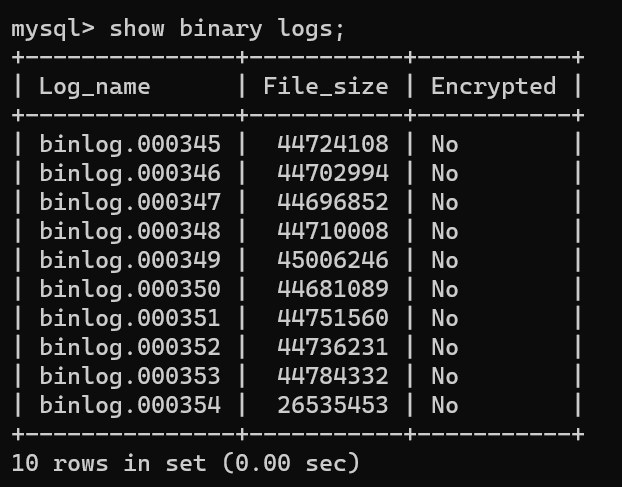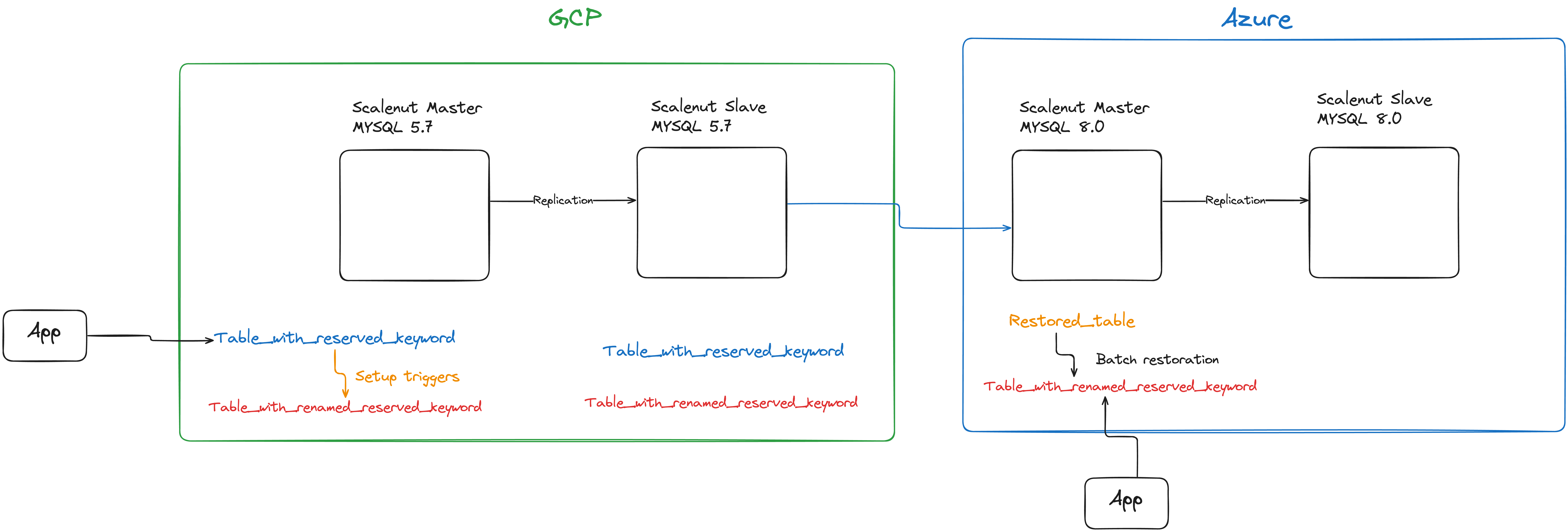MySQL 5.7 to MySQL 8.0 Migration Documentation
1. Overview
Migrating from MySQL 5.7 to MySQL 8.0 introduces several challenges due to changes in collations, reserved keywords, user management, replication, and downtime management. This documentation outlines key challenges, solutions, and best practices for a smooth migration.

2. Collation Challenges
Problem Statement
MySQL 8.0 defaults to utf8mb4 with new collations (utf8mb4_0900_ai_ci), which are incompatible with MySQL 5.7’s utf8mb4_general_ci.
Challenges
- Sorting & Comparison Differences: Queries may return different results.
- Index Rebuilds Required: Tables with old collations may need restructuring.
- Application Compatibility Issues: Some queries may fail or behave unexpectedly.
Solution
- Explicitly Set Collation in Dumps:
mysqldump --default-character-set=utf8mb4 --skip-set-charset ...
- Convert Existing Tables:
ALTER TABLE table_name CONVERT TO CHARACTER SET utf8mb4 COLLATE utf8mb4_0900_ai_ci;
- Test Queries: Verify application behavior with new collations before full migration.
Best Practices
✅ Pre-Migration Check: Identify tables with non-standard collations.
✅ Standardize Collations: Ensure all databases use utf8mb4_0900_ai_ci where possible.
✅ Backup Before Changes: Always take a backup before altering collations.
3. Reserved Keyword Challenges
Problem Statement
MySQL 8.0 introduces new reserved keywords (RANK, SYSTEM, WINDOW, etc.), causing conflicts if used as column/table names in MySQL 5.7.
Challenges
- Schema Restoration Failures: SQL imports may fail due to keyword conflicts.
- Application Errors: Queries referencing reserved words break.
Solution
- Identify Conflicts:
SELECT TABLE_NAME, COLUMN_NAME FROM INFORMATION_SCHEMA.COLUMNS WHERE COLUMN_NAME IN ('RANK', 'SYSTEM', 'WINDOW');
- Escape Keywords with Backticks:
SELECT `RANK` FROM `table_name`;
- Rename Problematic Columns:
ALTER TABLE table_name CHANGE `RANK` `user_rank` INT;
Best Practices
✅ Dry-Run Migration: Test schema restoration in a staging environment.
✅ Update Application Code: Replace reserved keywords with alternatives.
✅ Use Backticks Consistently: Ensure SQL queries escape keywords properly.
4. User Migration Challenges
Problem Statement
MySQL 8.0 restructures the mysql.user table, making direct migration from 5.7 problematic.
Challenges
- Failed User Imports: Direct
mysqldumpof users may not work. - Authentication Issues: Password hashing changes (
caching_sha2_passwordvsmysql_native_password).
Solution
- Use
mysql_native_passwordfor Backward Compatibility:
CREATE USER 'user'@'host' IDENTIFIED WITH mysql_native_password BY 'password';
- Export Grants Instead of Direct User Dump:
mysql -e "SHOW GRANTS FOR 'user'@'host';" > grants.sql
- Use MySQL Shell for Migration:
mysqlsh -- util dumpUsers output_file.sql
Best Practices
✅ Audit Users Before Migration: List all users and privileges.
✅ Test Authentication: Ensure applications can connect with new passwords.
✅ Use MySQL 8.0’s mysql.upgrade Tool: Helps migrate system tables.
5. Chained Replication Setup
Problem Statement
Setting up replication from MySQL 5.7 → MySQL 8.0 requires proper binary log configuration.
Challenges
- Replication Breaks: If
binlog_formatis notROW. - Data Drift: Inconsistent data if replication is misconfigured.
Solution
- Enable
ROWBinary Logging in 5.7:
SET GLOBAL binlog_format = 'ROW';
- Verify Replication User Privileges:
GRANT REPLICATION SLAVE ON *.* TO 'repl_user'@'%';
Best Practices
✅ Test Replication Before Cutover: Ensure data syncs correctly.
✅ Monitor Replication Lag: Use SHOW SLAVE STATUS\G.
✅ Use GTID for Reliability: Simplifies failover and recovery.
6. Achieving Minimal Downtime
Problem Statement
Minimizing downtime during migration is critical for business continuity.
Challenges
- Application Disruptions: If cutover is not smooth.
- Data Loss Risk: If replication is not synchronized.
Solution
- Use Replication-Based Cutover:
- Set up 8.0 as a replica of 5.7.
- Stop writes on 5.7, sync remaining changes.
- Promote 8.0 as the new master.
- Do sanity after switchover internally before making it live .
Best Practices
✅ Schedule Migration During Low Traffic.
✅ Validate Data Consistency Before Cutover.
✅ Have a Rollback Plan.
7. Cost Optimization
Challenge: Binary Log Management During Bulk Restoration
When performing large-scale database restorations, MySQL’s default binary logging behavior can slow down the process because:
-
If
max_binlog_sizeis too small (e.g.,100M), frequent log rotations occur, diverting resources from restoration to log file creation/switching. -
If binary logs aren’t purged automatically, they can fill up disk space, causing:
- “Disk Full” errors, halting restoration.
- Unnecessary storage costs (especially in cloud environments).

Solution
- Temporarily Increase
max_binlog_sizefor Bulk Operations
SET GLOBAL max_binlog_size = 1073741824; -- 1GB (larger files = fewer rotations)
- Why? Reduces I/O overhead during restoration by minimizing rotations.
- Revert after restoration if smaller logs are preferred for replication.
- Disable Binary Logging During Restoration (If Safe)
mysql --init-command="SET SQL_LOG_BIN=0;" < backup.sql
- Use Case: When restoring from a backup and replication isn’t needed.
- Automate Log Purging
SET GLOBAL binlog_expire_logs_seconds = 86400; -- Keep logs for 1 day (adjust as needed)
- Prevents disk exhaustion by auto-deleting old logs.
Best Practices
✅ Pre-Restoration Check: Ensure disk has 2x the backup size free.
✅ For Replicated Environments: Keep binary logging enabled but increase max_binlog_size.
 ✅ Post-Restoration:
✅ Post-Restoration:
- Re-enable binary logging (if disabled).
- Reset
max_binlog_sizeif smaller files are preferred.
🛠️ MySQL Migration & Optimization Guide
📌 Problem: Auto-Update Column
You want to create a table with an auto-updating timestamp column (e.g., updated_at) that reflects the last modified time of each row.
✅ Recommended DDL
CREATE TABLE users (
id INT PRIMARY KEY,
name VARCHAR(100),
created_at TIMESTAMP DEFAULT CURRENT_TIMESTAMP,
updated_at TIMESTAMP DEFAULT CURRENT_TIMESTAMP ON UPDATE CURRENT_TIMESTAMP
);- created_at: Automatically set on insert.
- updated_at: Automatically set on insert and updated on every row modification.
🗄️ Sample Table DDL: analysis_citations
CREATE TABLE `analysis_citations` (
`id` int(11) NOT NULL AUTO_INCREMENT,
`report_id` int(11) DEFAULT NULL,
`url` varchar(100) COLLATE utf8_unicode_ci DEFAULT NULL,
`rank` int(11) DEFAULT NULL,
`citation_link` varchar(2500) COLLATE utf8_unicode_ci DEFAULT NULL,
`citation_title` varchar(255) COLLATE utf8_unicode_ci DEFAULT NULL,
`url_host` varchar(150) COLLATE utf8_unicode_ci DEFAULT NULL,
`created_at` timestamp NULL DEFAULT CURRENT_TIMESTAMP,
`anchor_text` varchar(500) COLLATE utf8_unicode_ci DEFAULT NULL,
PRIMARY KEY (`id`),
KEY `report id` (`report_id`),
KEY `url host` (`url_host`),
KEY `citiation link` (`citation_link`(1024)),
KEY `url` (`url`)
) ENGINE=InnoDB AUTO_INCREMENT=81731627 DEFAULT CHARSET=utf8 COLLATE=utf8_unicode_ci;🚀 Best Practices: Dump + Restore & Replication
- Use native MySQL dump/restore for migration.
- Ensure replication compatibility between versions.
⚙️ Large Database Restoration Optimization
📦 Max Packet Size Error
🔍 Problem
During migration of large tables (e.g., clickstream), default max_allowed_packet may be too small.
✅ Solution: Enable Chunking
- Chunk by record count or size.
💡 Recommended Settings
| Scenario | Recommended max_allowed_packet |
|---|---|
| Small records | 16M–64M |
| Medium (clickstream) | 64M–128M |
| Large BLOBs (images) | 128M–256M |
| Bulk loads | 256M–1G |
🔄 innodb_flush_log_at_trx_commit
| Setting | Description | Use Case |
|---|---|---|
| 1 (default) | Safe, flush on every commit | Production |
| 2 | Flush once per second | Restores (low risk) |
| 0 | Fastest, least safe | Restores (test only) |
🔄 Set to
2during restore, then revert to1.
💾 innodb_flush_method
| Method | Description |
|---|---|
fsync | Default, reliable |
O_DSYNC | Immediate log sync |
O_DIRECT | Skips OS cache, efficient |
O_DIRECT_NO_FSYNC | Risky, no final sync |
✅ Recommended: Use
O_DIRECTfor better I/O during large restores.
🧠 innodb_buffer_pool_size
- Increase to 70–80% of available RAM.
- Prevents frequent disk I/O during restores.
innodb_buffer_pool_size = 12G # Example for 16GB RAM🗂️ innodb_log_file_size
- Bigger logs = fewer checkpoints = faster restores.
- Common size: 1–2 GB
🔁 Requires MySQL restart after change.
🔤 Collation Challenges (MySQL 5.7 → 8.0)
❗ Problem
- MySQL 5.7
utf8= utf8mb3 (3-byte, no emoji support) - MySQL 8.0 defaults to utf8mb4
- Collation mismatches can cause data corruption
✅ Solution Matrix
| MySQL 5.7 Source | MySQL 8.0 Target | Notes |
|---|---|---|
utf8mb4 | utf8mb4 | Best, full Unicode |
utf8 (utf8mb3) | utf8mb3 | Legacy-compatible |
utf8mb3 | utf8mb3 | Explicit legacy mode |
🎯 Prefer utf8mb4 end-to-end for Unicode consistency.
📝 Notes
- Always test on staging before full migration.
- Use replication lag monitoring during live cutovers.
- Consider character set upgrade scripts for safe conversion.
✅ Summary
| Component | Recommendation |
|---|---|
| Auto-update column | ON UPDATE CURRENT_TIMESTAMP |
| Large restore | Chunked + tune memory/disk params |
| Flush method | Use O_DIRECT |
| Buffer pool | 70–80% of RAM |
| Log file size | 1–2 GB |
| Collation | Prefer utf8mb4 for future-proofing |